Economics Assignment: Analysis of Rent Control Policies in Cities
VerifiedAdded on 2020/04/15
|8
|2198
|266
Essay
AI Summary
This economics assignment delves into the concept of rent control within the housing sector of large cities. It begins by defining the market and the interplay of supply and demand, highlighting the role of government intervention when market mechanisms fail, especially concerning housing affordability. The essay then focuses on rent control, analyzing its positive aspects, such as providing affordable housing, improving efficiency, and addressing contractual issues. Conversely, it examines the negative implications, including reduced housing supply, decreased quality, potential discrimination, and increased eviction rates. The analysis employs diagrams to illustrate the short-run and long-run effects of price ceilings, concluding with a discussion on the need for balanced policies, including increasing the supply of housing, to address housing affordability challenges effectively. The assignment emphasizes the complexities and trade-offs associated with rent control policies, offering a comprehensive overview of its economic consequences.
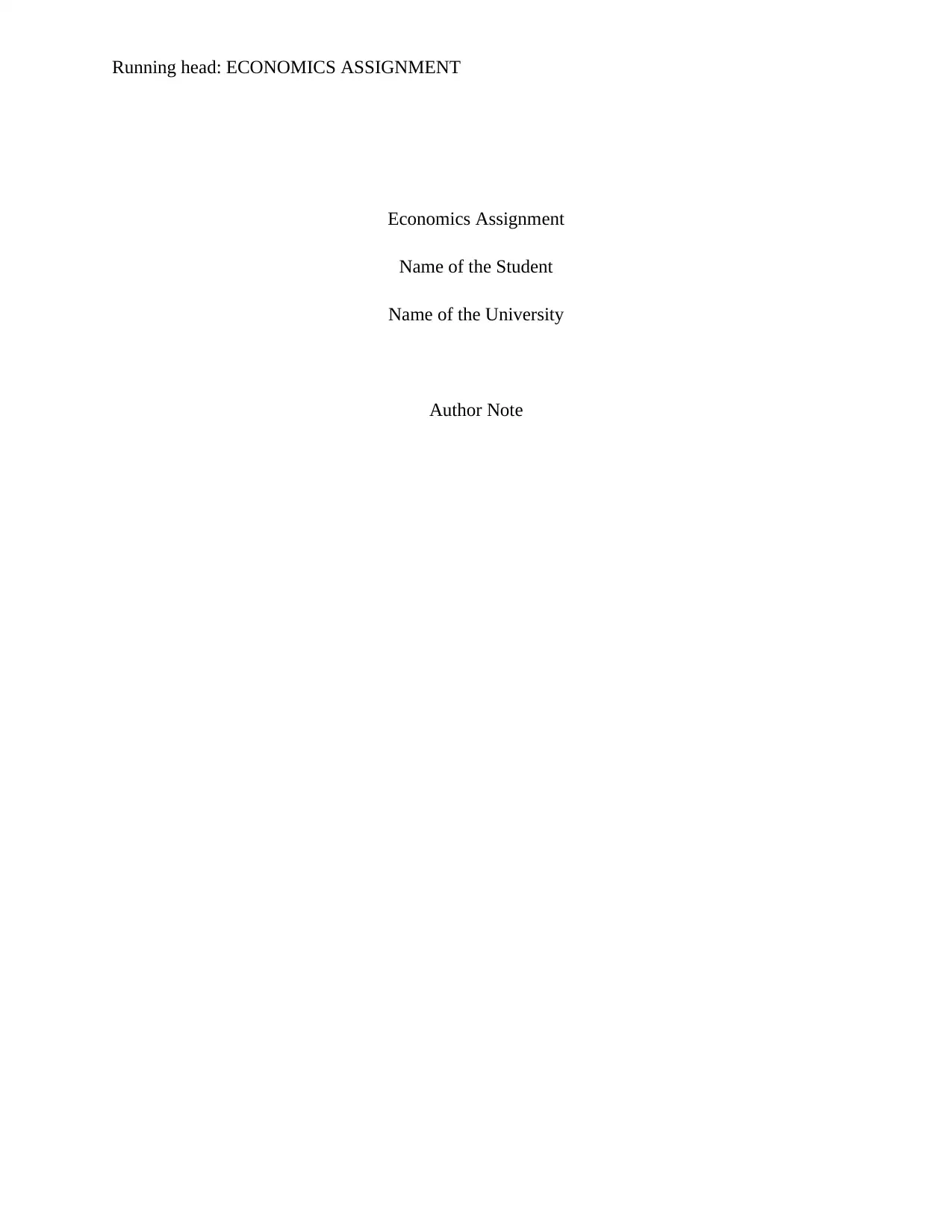
Running head: ECONOMICS ASSIGNMENT
Economics Assignment
Name of the Student
Name of the University
Author Note
Economics Assignment
Name of the Student
Name of the University
Author Note
Paraphrase This Document
Need a fresh take? Get an instant paraphrase of this document with our AI Paraphraser
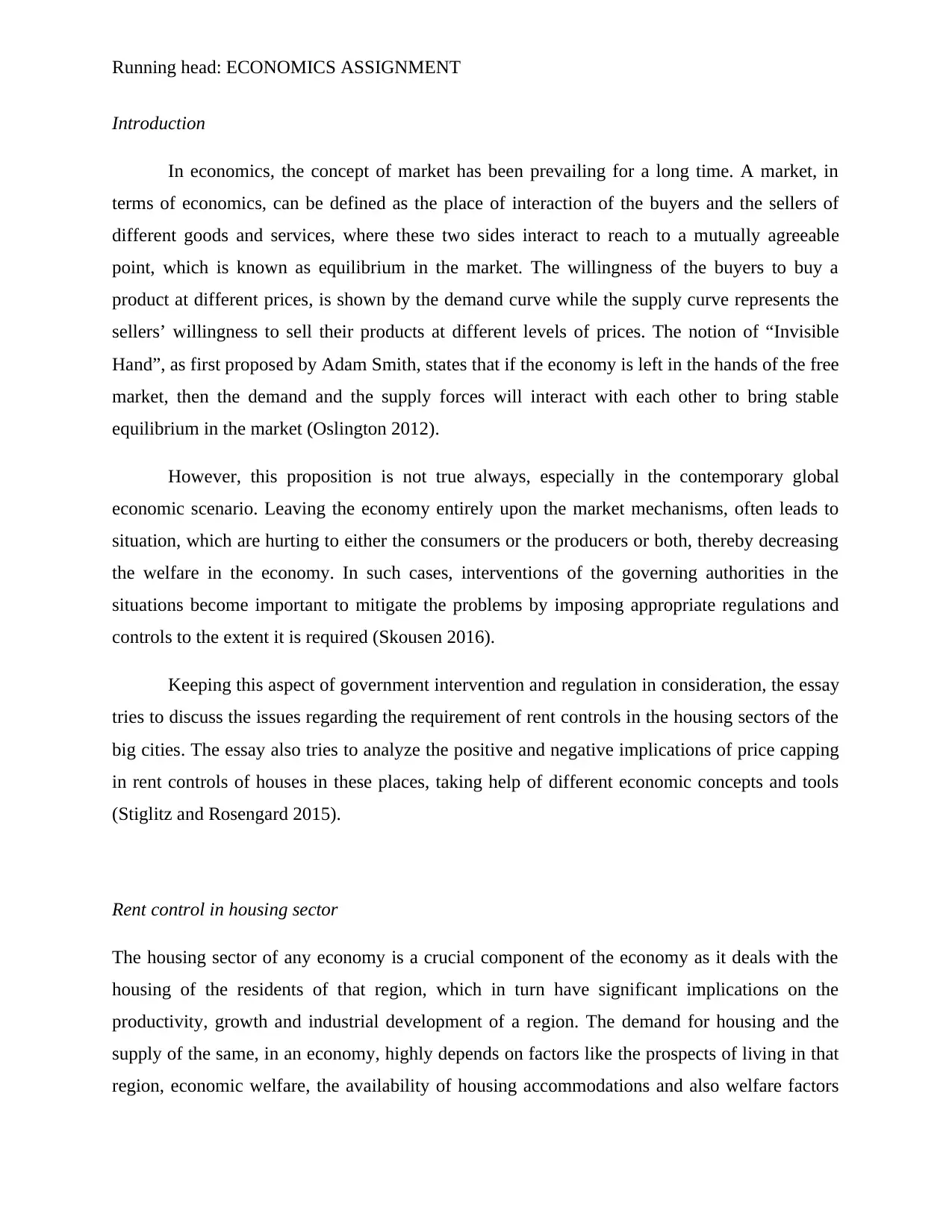
Running head: ECONOMICS ASSIGNMENT
Introduction
In economics, the concept of market has been prevailing for a long time. A market, in
terms of economics, can be defined as the place of interaction of the buyers and the sellers of
different goods and services, where these two sides interact to reach to a mutually agreeable
point, which is known as equilibrium in the market. The willingness of the buyers to buy a
product at different prices, is shown by the demand curve while the supply curve represents the
sellers’ willingness to sell their products at different levels of prices. The notion of “Invisible
Hand”, as first proposed by Adam Smith, states that if the economy is left in the hands of the free
market, then the demand and the supply forces will interact with each other to bring stable
equilibrium in the market (Oslington 2012).
However, this proposition is not true always, especially in the contemporary global
economic scenario. Leaving the economy entirely upon the market mechanisms, often leads to
situation, which are hurting to either the consumers or the producers or both, thereby decreasing
the welfare in the economy. In such cases, interventions of the governing authorities in the
situations become important to mitigate the problems by imposing appropriate regulations and
controls to the extent it is required (Skousen 2016).
Keeping this aspect of government intervention and regulation in consideration, the essay
tries to discuss the issues regarding the requirement of rent controls in the housing sectors of the
big cities. The essay also tries to analyze the positive and negative implications of price capping
in rent controls of houses in these places, taking help of different economic concepts and tools
(Stiglitz and Rosengard 2015).
Rent control in housing sector
The housing sector of any economy is a crucial component of the economy as it deals with the
housing of the residents of that region, which in turn have significant implications on the
productivity, growth and industrial development of a region. The demand for housing and the
supply of the same, in an economy, highly depends on factors like the prospects of living in that
region, economic welfare, the availability of housing accommodations and also welfare factors
Introduction
In economics, the concept of market has been prevailing for a long time. A market, in
terms of economics, can be defined as the place of interaction of the buyers and the sellers of
different goods and services, where these two sides interact to reach to a mutually agreeable
point, which is known as equilibrium in the market. The willingness of the buyers to buy a
product at different prices, is shown by the demand curve while the supply curve represents the
sellers’ willingness to sell their products at different levels of prices. The notion of “Invisible
Hand”, as first proposed by Adam Smith, states that if the economy is left in the hands of the free
market, then the demand and the supply forces will interact with each other to bring stable
equilibrium in the market (Oslington 2012).
However, this proposition is not true always, especially in the contemporary global
economic scenario. Leaving the economy entirely upon the market mechanisms, often leads to
situation, which are hurting to either the consumers or the producers or both, thereby decreasing
the welfare in the economy. In such cases, interventions of the governing authorities in the
situations become important to mitigate the problems by imposing appropriate regulations and
controls to the extent it is required (Skousen 2016).
Keeping this aspect of government intervention and regulation in consideration, the essay
tries to discuss the issues regarding the requirement of rent controls in the housing sectors of the
big cities. The essay also tries to analyze the positive and negative implications of price capping
in rent controls of houses in these places, taking help of different economic concepts and tools
(Stiglitz and Rosengard 2015).
Rent control in housing sector
The housing sector of any economy is a crucial component of the economy as it deals with the
housing of the residents of that region, which in turn have significant implications on the
productivity, growth and industrial development of a region. The demand for housing and the
supply of the same, in an economy, highly depends on factors like the prospects of living in that
region, economic welfare, the availability of housing accommodations and also welfare factors
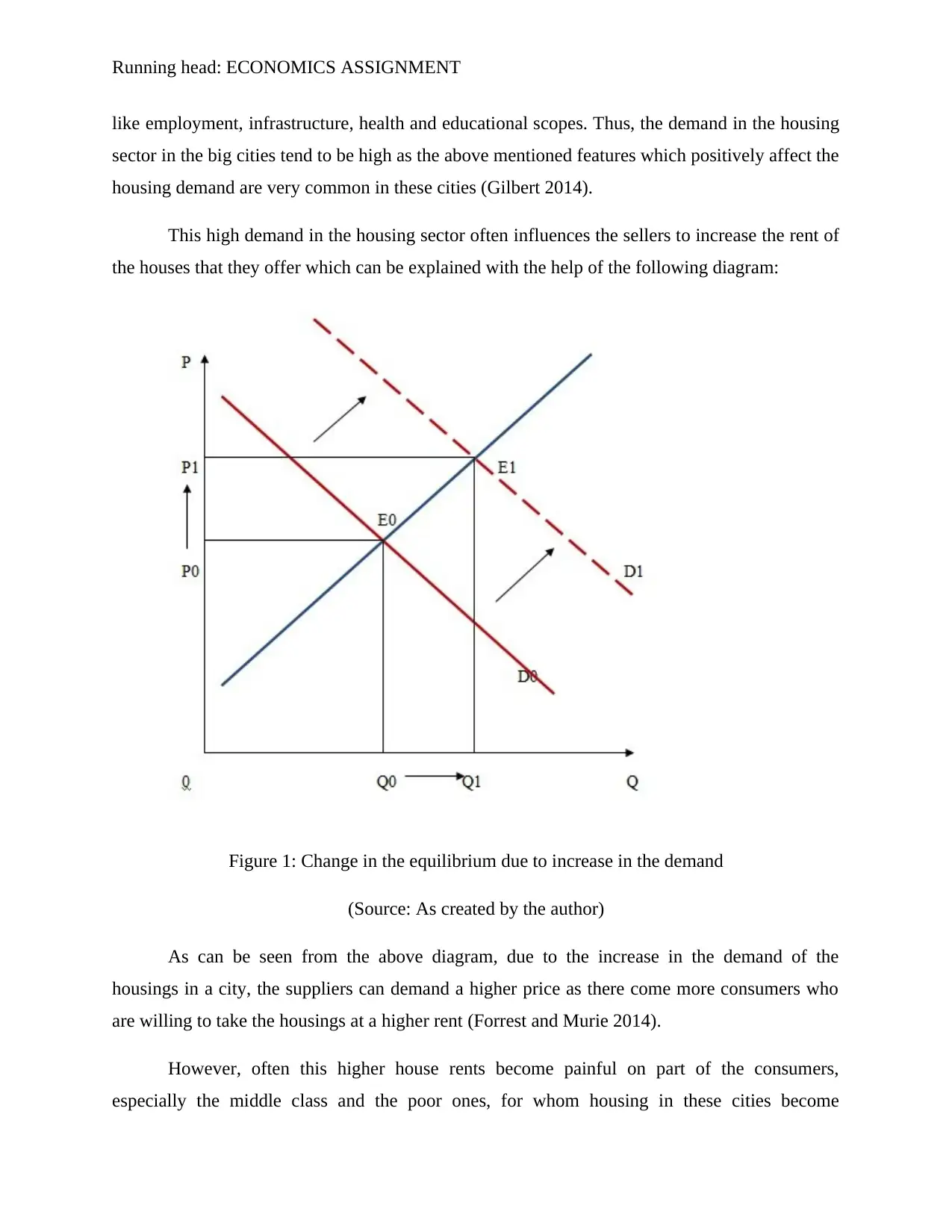
Running head: ECONOMICS ASSIGNMENT
like employment, infrastructure, health and educational scopes. Thus, the demand in the housing
sector in the big cities tend to be high as the above mentioned features which positively affect the
housing demand are very common in these cities (Gilbert 2014).
This high demand in the housing sector often influences the sellers to increase the rent of
the houses that they offer which can be explained with the help of the following diagram:
Figure 1: Change in the equilibrium due to increase in the demand
(Source: As created by the author)
As can be seen from the above diagram, due to the increase in the demand of the
housings in a city, the suppliers can demand a higher price as there come more consumers who
are willing to take the housings at a higher rent (Forrest and Murie 2014).
However, often this higher house rents become painful on part of the consumers,
especially the middle class and the poor ones, for whom housing in these cities become
like employment, infrastructure, health and educational scopes. Thus, the demand in the housing
sector in the big cities tend to be high as the above mentioned features which positively affect the
housing demand are very common in these cities (Gilbert 2014).
This high demand in the housing sector often influences the sellers to increase the rent of
the houses that they offer which can be explained with the help of the following diagram:
Figure 1: Change in the equilibrium due to increase in the demand
(Source: As created by the author)
As can be seen from the above diagram, due to the increase in the demand of the
housings in a city, the suppliers can demand a higher price as there come more consumers who
are willing to take the housings at a higher rent (Forrest and Murie 2014).
However, often this higher house rents become painful on part of the consumers,
especially the middle class and the poor ones, for whom housing in these cities become
⊘ This is a preview!⊘
Do you want full access?
Subscribe today to unlock all pages.

Trusted by 1+ million students worldwide
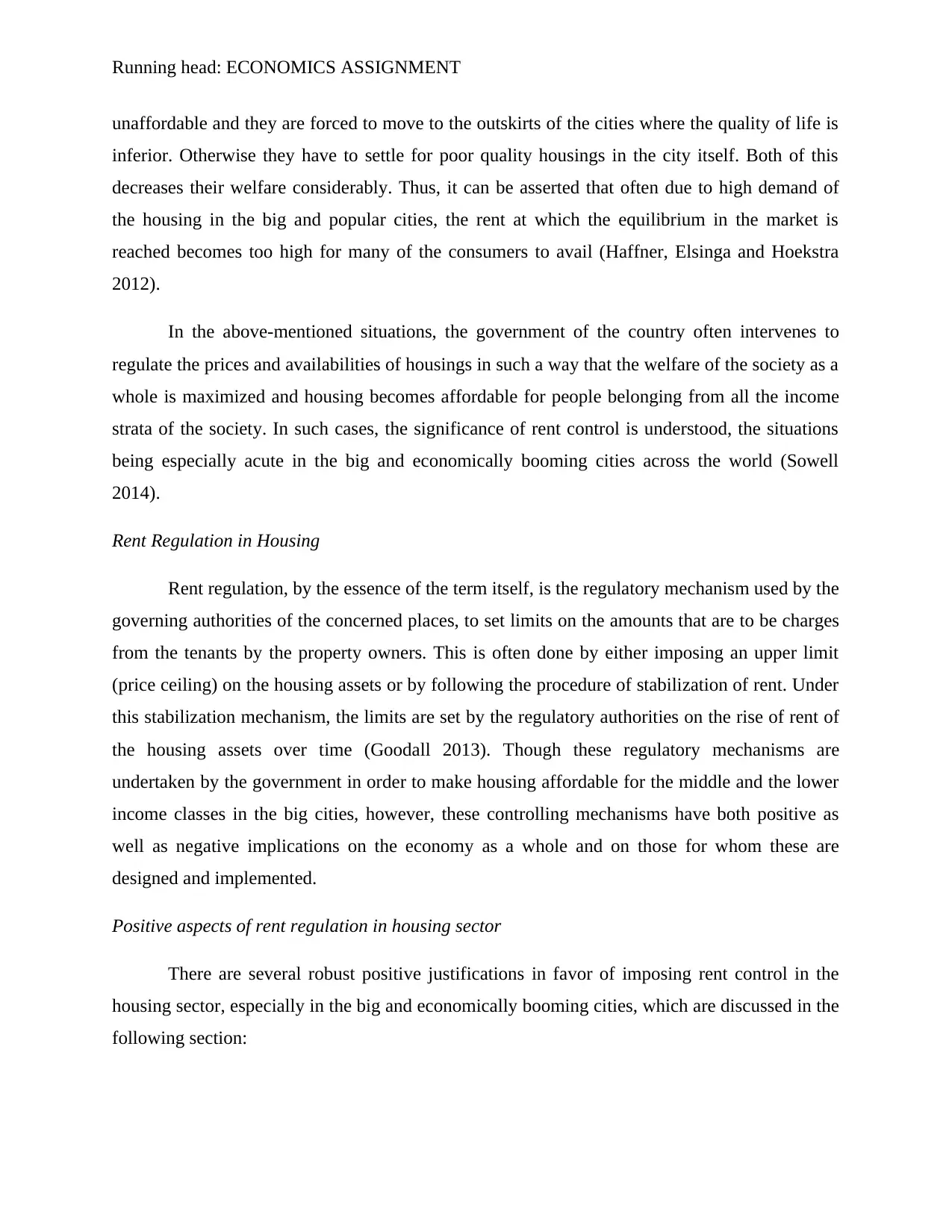
Running head: ECONOMICS ASSIGNMENT
unaffordable and they are forced to move to the outskirts of the cities where the quality of life is
inferior. Otherwise they have to settle for poor quality housings in the city itself. Both of this
decreases their welfare considerably. Thus, it can be asserted that often due to high demand of
the housing in the big and popular cities, the rent at which the equilibrium in the market is
reached becomes too high for many of the consumers to avail (Haffner, Elsinga and Hoekstra
2012).
In the above-mentioned situations, the government of the country often intervenes to
regulate the prices and availabilities of housings in such a way that the welfare of the society as a
whole is maximized and housing becomes affordable for people belonging from all the income
strata of the society. In such cases, the significance of rent control is understood, the situations
being especially acute in the big and economically booming cities across the world (Sowell
2014).
Rent Regulation in Housing
Rent regulation, by the essence of the term itself, is the regulatory mechanism used by the
governing authorities of the concerned places, to set limits on the amounts that are to be charges
from the tenants by the property owners. This is often done by either imposing an upper limit
(price ceiling) on the housing assets or by following the procedure of stabilization of rent. Under
this stabilization mechanism, the limits are set by the regulatory authorities on the rise of rent of
the housing assets over time (Goodall 2013). Though these regulatory mechanisms are
undertaken by the government in order to make housing affordable for the middle and the lower
income classes in the big cities, however, these controlling mechanisms have both positive as
well as negative implications on the economy as a whole and on those for whom these are
designed and implemented.
Positive aspects of rent regulation in housing sector
There are several robust positive justifications in favor of imposing rent control in the
housing sector, especially in the big and economically booming cities, which are discussed in the
following section:
unaffordable and they are forced to move to the outskirts of the cities where the quality of life is
inferior. Otherwise they have to settle for poor quality housings in the city itself. Both of this
decreases their welfare considerably. Thus, it can be asserted that often due to high demand of
the housing in the big and popular cities, the rent at which the equilibrium in the market is
reached becomes too high for many of the consumers to avail (Haffner, Elsinga and Hoekstra
2012).
In the above-mentioned situations, the government of the country often intervenes to
regulate the prices and availabilities of housings in such a way that the welfare of the society as a
whole is maximized and housing becomes affordable for people belonging from all the income
strata of the society. In such cases, the significance of rent control is understood, the situations
being especially acute in the big and economically booming cities across the world (Sowell
2014).
Rent Regulation in Housing
Rent regulation, by the essence of the term itself, is the regulatory mechanism used by the
governing authorities of the concerned places, to set limits on the amounts that are to be charges
from the tenants by the property owners. This is often done by either imposing an upper limit
(price ceiling) on the housing assets or by following the procedure of stabilization of rent. Under
this stabilization mechanism, the limits are set by the regulatory authorities on the rise of rent of
the housing assets over time (Goodall 2013). Though these regulatory mechanisms are
undertaken by the government in order to make housing affordable for the middle and the lower
income classes in the big cities, however, these controlling mechanisms have both positive as
well as negative implications on the economy as a whole and on those for whom these are
designed and implemented.
Positive aspects of rent regulation in housing sector
There are several robust positive justifications in favor of imposing rent control in the
housing sector, especially in the big and economically booming cities, which are discussed in the
following section:
Paraphrase This Document
Need a fresh take? Get an instant paraphrase of this document with our AI Paraphraser
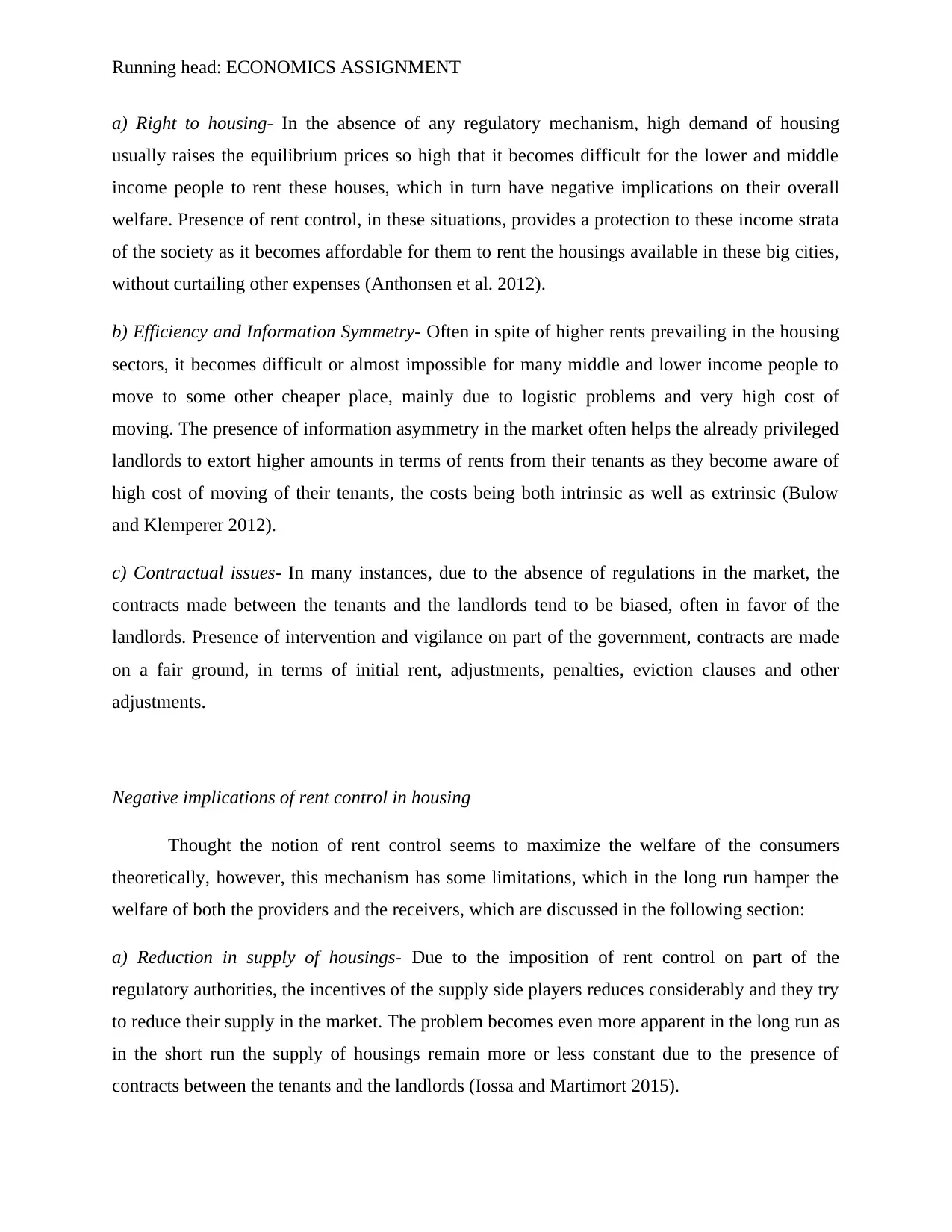
Running head: ECONOMICS ASSIGNMENT
a) Right to housing- In the absence of any regulatory mechanism, high demand of housing
usually raises the equilibrium prices so high that it becomes difficult for the lower and middle
income people to rent these houses, which in turn have negative implications on their overall
welfare. Presence of rent control, in these situations, provides a protection to these income strata
of the society as it becomes affordable for them to rent the housings available in these big cities,
without curtailing other expenses (Anthonsen et al. 2012).
b) Efficiency and Information Symmetry- Often in spite of higher rents prevailing in the housing
sectors, it becomes difficult or almost impossible for many middle and lower income people to
move to some other cheaper place, mainly due to logistic problems and very high cost of
moving. The presence of information asymmetry in the market often helps the already privileged
landlords to extort higher amounts in terms of rents from their tenants as they become aware of
high cost of moving of their tenants, the costs being both intrinsic as well as extrinsic (Bulow
and Klemperer 2012).
c) Contractual issues- In many instances, due to the absence of regulations in the market, the
contracts made between the tenants and the landlords tend to be biased, often in favor of the
landlords. Presence of intervention and vigilance on part of the government, contracts are made
on a fair ground, in terms of initial rent, adjustments, penalties, eviction clauses and other
adjustments.
Negative implications of rent control in housing
Thought the notion of rent control seems to maximize the welfare of the consumers
theoretically, however, this mechanism has some limitations, which in the long run hamper the
welfare of both the providers and the receivers, which are discussed in the following section:
a) Reduction in supply of housings- Due to the imposition of rent control on part of the
regulatory authorities, the incentives of the supply side players reduces considerably and they try
to reduce their supply in the market. The problem becomes even more apparent in the long run as
in the short run the supply of housings remain more or less constant due to the presence of
contracts between the tenants and the landlords (Iossa and Martimort 2015).
a) Right to housing- In the absence of any regulatory mechanism, high demand of housing
usually raises the equilibrium prices so high that it becomes difficult for the lower and middle
income people to rent these houses, which in turn have negative implications on their overall
welfare. Presence of rent control, in these situations, provides a protection to these income strata
of the society as it becomes affordable for them to rent the housings available in these big cities,
without curtailing other expenses (Anthonsen et al. 2012).
b) Efficiency and Information Symmetry- Often in spite of higher rents prevailing in the housing
sectors, it becomes difficult or almost impossible for many middle and lower income people to
move to some other cheaper place, mainly due to logistic problems and very high cost of
moving. The presence of information asymmetry in the market often helps the already privileged
landlords to extort higher amounts in terms of rents from their tenants as they become aware of
high cost of moving of their tenants, the costs being both intrinsic as well as extrinsic (Bulow
and Klemperer 2012).
c) Contractual issues- In many instances, due to the absence of regulations in the market, the
contracts made between the tenants and the landlords tend to be biased, often in favor of the
landlords. Presence of intervention and vigilance on part of the government, contracts are made
on a fair ground, in terms of initial rent, adjustments, penalties, eviction clauses and other
adjustments.
Negative implications of rent control in housing
Thought the notion of rent control seems to maximize the welfare of the consumers
theoretically, however, this mechanism has some limitations, which in the long run hamper the
welfare of both the providers and the receivers, which are discussed in the following section:
a) Reduction in supply of housings- Due to the imposition of rent control on part of the
regulatory authorities, the incentives of the supply side players reduces considerably and they try
to reduce their supply in the market. The problem becomes even more apparent in the long run as
in the short run the supply of housings remain more or less constant due to the presence of
contracts between the tenants and the landlords (Iossa and Martimort 2015).
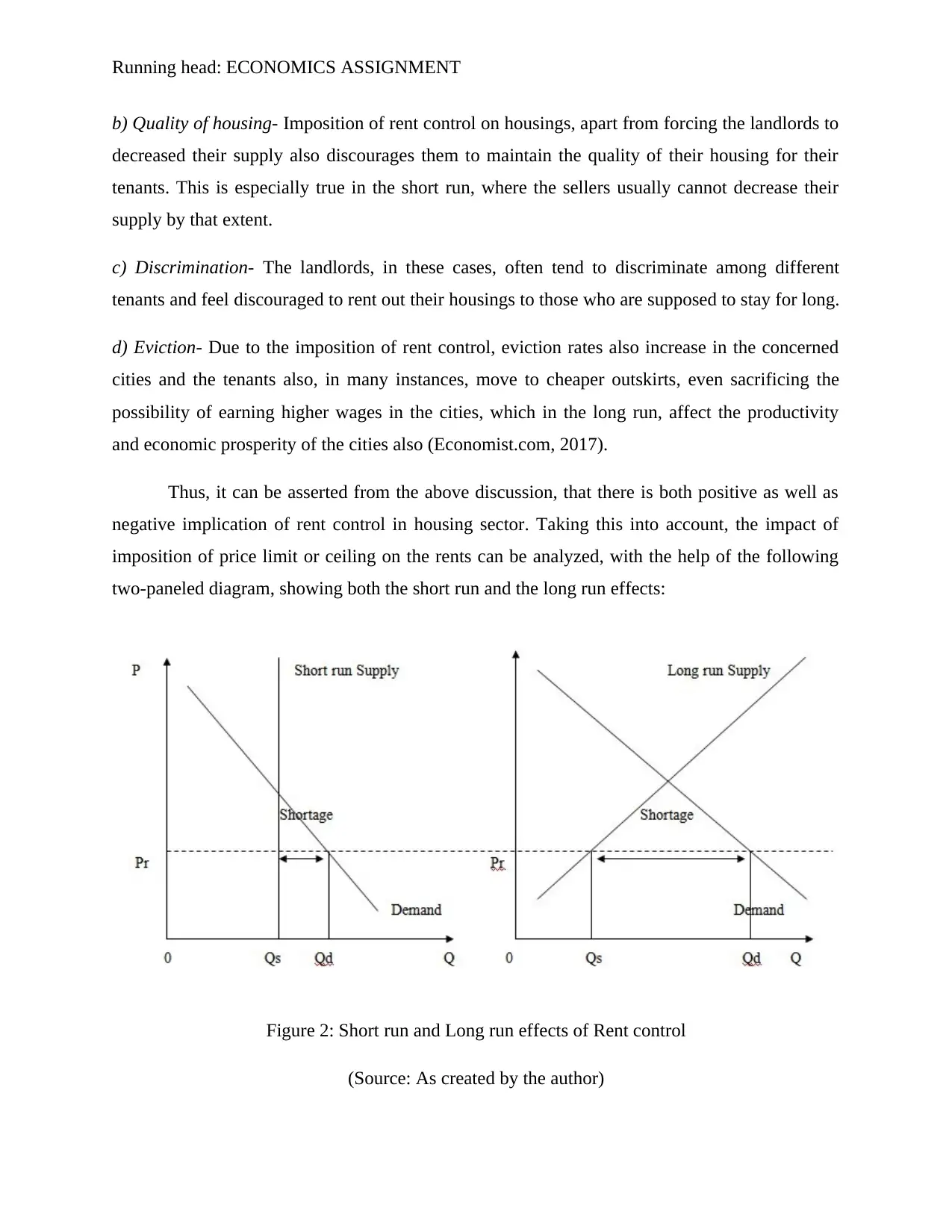
Running head: ECONOMICS ASSIGNMENT
b) Quality of housing- Imposition of rent control on housings, apart from forcing the landlords to
decreased their supply also discourages them to maintain the quality of their housing for their
tenants. This is especially true in the short run, where the sellers usually cannot decrease their
supply by that extent.
c) Discrimination- The landlords, in these cases, often tend to discriminate among different
tenants and feel discouraged to rent out their housings to those who are supposed to stay for long.
d) Eviction- Due to the imposition of rent control, eviction rates also increase in the concerned
cities and the tenants also, in many instances, move to cheaper outskirts, even sacrificing the
possibility of earning higher wages in the cities, which in the long run, affect the productivity
and economic prosperity of the cities also (Economist.com, 2017).
Thus, it can be asserted from the above discussion, that there is both positive as well as
negative implication of rent control in housing sector. Taking this into account, the impact of
imposition of price limit or ceiling on the rents can be analyzed, with the help of the following
two-paneled diagram, showing both the short run and the long run effects:
Figure 2: Short run and Long run effects of Rent control
(Source: As created by the author)
b) Quality of housing- Imposition of rent control on housings, apart from forcing the landlords to
decreased their supply also discourages them to maintain the quality of their housing for their
tenants. This is especially true in the short run, where the sellers usually cannot decrease their
supply by that extent.
c) Discrimination- The landlords, in these cases, often tend to discriminate among different
tenants and feel discouraged to rent out their housings to those who are supposed to stay for long.
d) Eviction- Due to the imposition of rent control, eviction rates also increase in the concerned
cities and the tenants also, in many instances, move to cheaper outskirts, even sacrificing the
possibility of earning higher wages in the cities, which in the long run, affect the productivity
and economic prosperity of the cities also (Economist.com, 2017).
Thus, it can be asserted from the above discussion, that there is both positive as well as
negative implication of rent control in housing sector. Taking this into account, the impact of
imposition of price limit or ceiling on the rents can be analyzed, with the help of the following
two-paneled diagram, showing both the short run and the long run effects:
Figure 2: Short run and Long run effects of Rent control
(Source: As created by the author)
⊘ This is a preview!⊘
Do you want full access?
Subscribe today to unlock all pages.

Trusted by 1+ million students worldwide
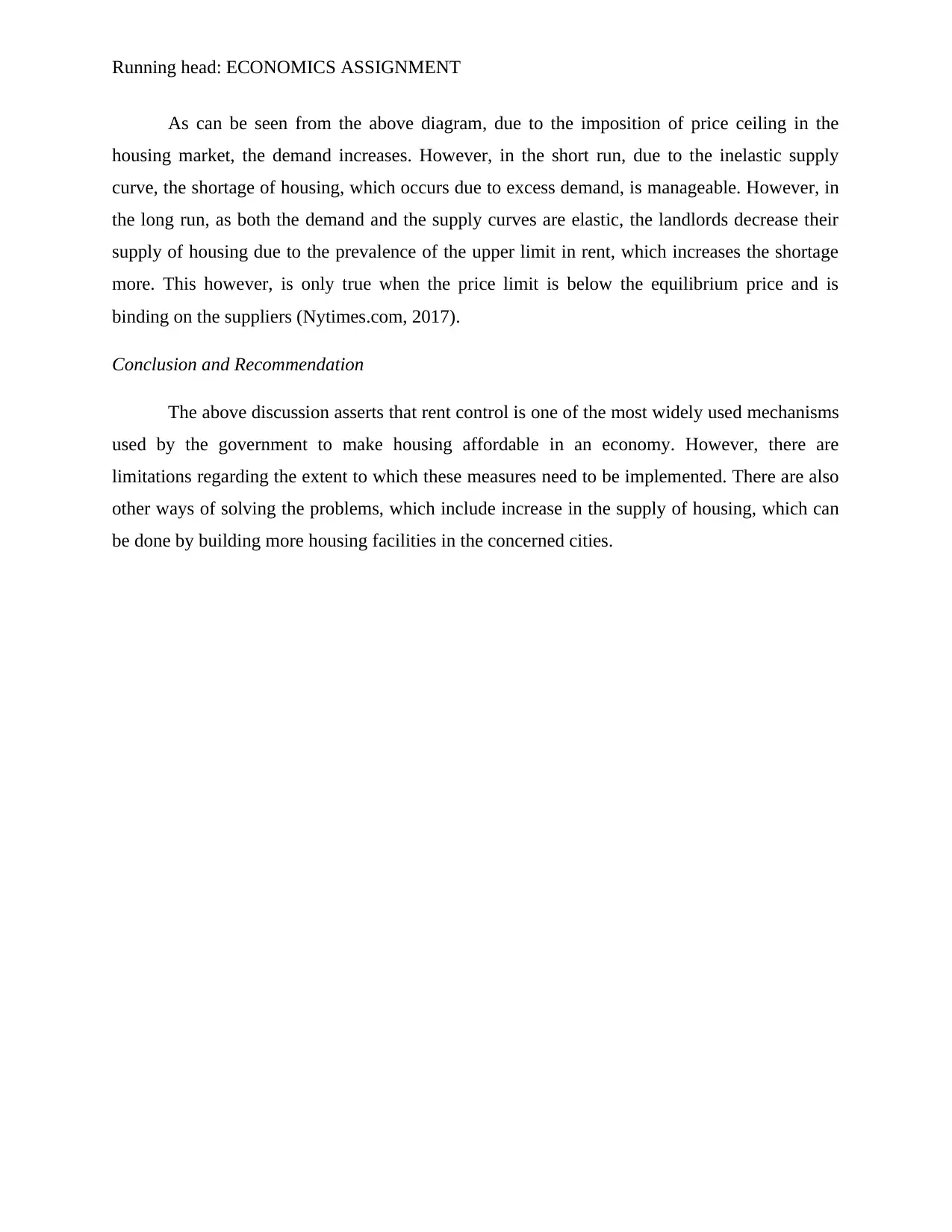
Running head: ECONOMICS ASSIGNMENT
As can be seen from the above diagram, due to the imposition of price ceiling in the
housing market, the demand increases. However, in the short run, due to the inelastic supply
curve, the shortage of housing, which occurs due to excess demand, is manageable. However, in
the long run, as both the demand and the supply curves are elastic, the landlords decrease their
supply of housing due to the prevalence of the upper limit in rent, which increases the shortage
more. This however, is only true when the price limit is below the equilibrium price and is
binding on the suppliers (Nytimes.com, 2017).
Conclusion and Recommendation
The above discussion asserts that rent control is one of the most widely used mechanisms
used by the government to make housing affordable in an economy. However, there are
limitations regarding the extent to which these measures need to be implemented. There are also
other ways of solving the problems, which include increase in the supply of housing, which can
be done by building more housing facilities in the concerned cities.
As can be seen from the above diagram, due to the imposition of price ceiling in the
housing market, the demand increases. However, in the short run, due to the inelastic supply
curve, the shortage of housing, which occurs due to excess demand, is manageable. However, in
the long run, as both the demand and the supply curves are elastic, the landlords decrease their
supply of housing due to the prevalence of the upper limit in rent, which increases the shortage
more. This however, is only true when the price limit is below the equilibrium price and is
binding on the suppliers (Nytimes.com, 2017).
Conclusion and Recommendation
The above discussion asserts that rent control is one of the most widely used mechanisms
used by the government to make housing affordable in an economy. However, there are
limitations regarding the extent to which these measures need to be implemented. There are also
other ways of solving the problems, which include increase in the supply of housing, which can
be done by building more housing facilities in the concerned cities.
Paraphrase This Document
Need a fresh take? Get an instant paraphrase of this document with our AI Paraphraser
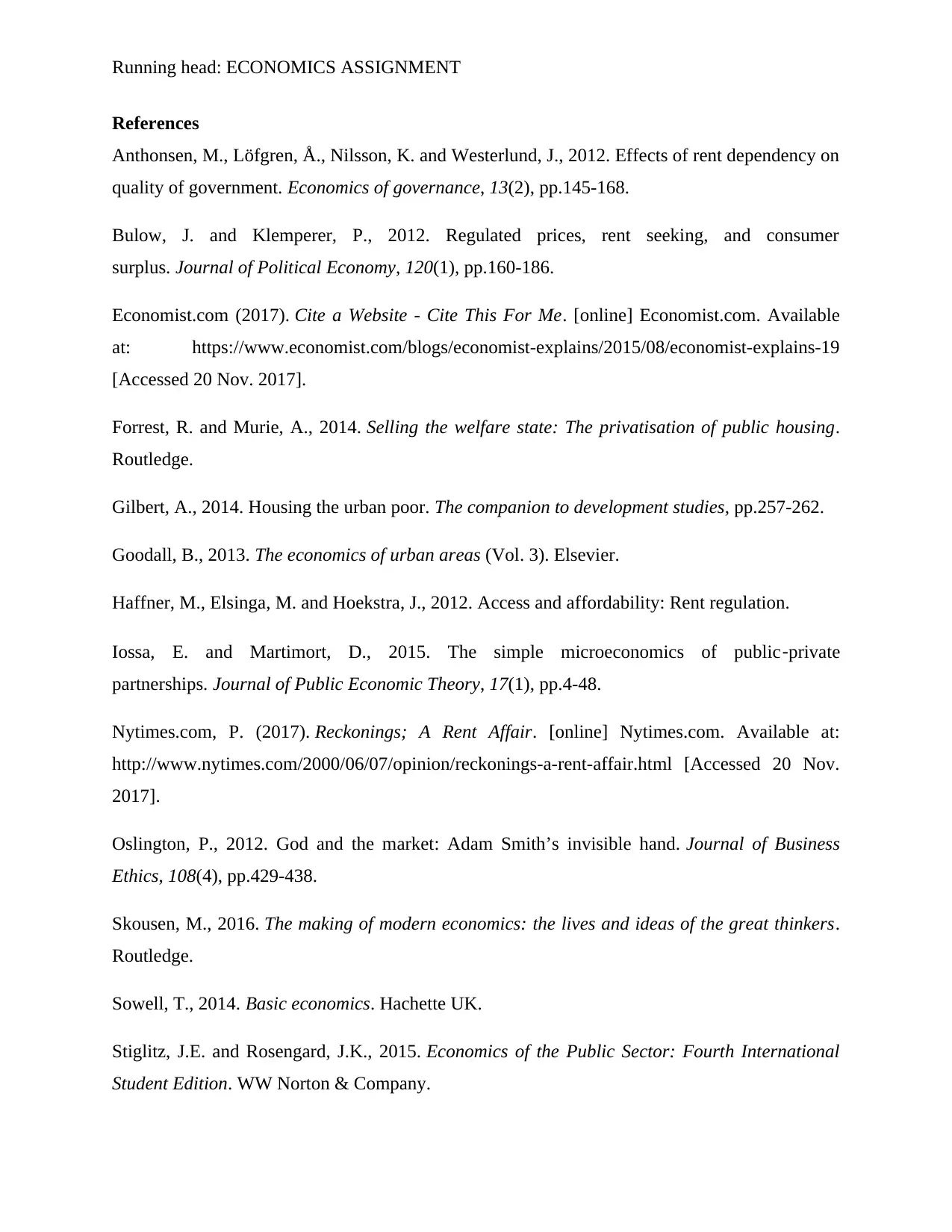
Running head: ECONOMICS ASSIGNMENT
References
Anthonsen, M., Löfgren, Å., Nilsson, K. and Westerlund, J., 2012. Effects of rent dependency on
quality of government. Economics of governance, 13(2), pp.145-168.
Bulow, J. and Klemperer, P., 2012. Regulated prices, rent seeking, and consumer
surplus. Journal of Political Economy, 120(1), pp.160-186.
Economist.com (2017). Cite a Website - Cite This For Me. [online] Economist.com. Available
at: https://www.economist.com/blogs/economist-explains/2015/08/economist-explains-19
[Accessed 20 Nov. 2017].
Forrest, R. and Murie, A., 2014. Selling the welfare state: The privatisation of public housing.
Routledge.
Gilbert, A., 2014. Housing the urban poor. The companion to development studies, pp.257-262.
Goodall, B., 2013. The economics of urban areas (Vol. 3). Elsevier.
Haffner, M., Elsinga, M. and Hoekstra, J., 2012. Access and affordability: Rent regulation.
Iossa, E. and Martimort, D., 2015. The simple microeconomics of public‐private
partnerships. Journal of Public Economic Theory, 17(1), pp.4-48.
Nytimes.com, P. (2017). Reckonings; A Rent Affair. [online] Nytimes.com. Available at:
http://www.nytimes.com/2000/06/07/opinion/reckonings-a-rent-affair.html [Accessed 20 Nov.
2017].
Oslington, P., 2012. God and the market: Adam Smith’s invisible hand. Journal of Business
Ethics, 108(4), pp.429-438.
Skousen, M., 2016. The making of modern economics: the lives and ideas of the great thinkers.
Routledge.
Sowell, T., 2014. Basic economics. Hachette UK.
Stiglitz, J.E. and Rosengard, J.K., 2015. Economics of the Public Sector: Fourth International
Student Edition. WW Norton & Company.
References
Anthonsen, M., Löfgren, Å., Nilsson, K. and Westerlund, J., 2012. Effects of rent dependency on
quality of government. Economics of governance, 13(2), pp.145-168.
Bulow, J. and Klemperer, P., 2012. Regulated prices, rent seeking, and consumer
surplus. Journal of Political Economy, 120(1), pp.160-186.
Economist.com (2017). Cite a Website - Cite This For Me. [online] Economist.com. Available
at: https://www.economist.com/blogs/economist-explains/2015/08/economist-explains-19
[Accessed 20 Nov. 2017].
Forrest, R. and Murie, A., 2014. Selling the welfare state: The privatisation of public housing.
Routledge.
Gilbert, A., 2014. Housing the urban poor. The companion to development studies, pp.257-262.
Goodall, B., 2013. The economics of urban areas (Vol. 3). Elsevier.
Haffner, M., Elsinga, M. and Hoekstra, J., 2012. Access and affordability: Rent regulation.
Iossa, E. and Martimort, D., 2015. The simple microeconomics of public‐private
partnerships. Journal of Public Economic Theory, 17(1), pp.4-48.
Nytimes.com, P. (2017). Reckonings; A Rent Affair. [online] Nytimes.com. Available at:
http://www.nytimes.com/2000/06/07/opinion/reckonings-a-rent-affair.html [Accessed 20 Nov.
2017].
Oslington, P., 2012. God and the market: Adam Smith’s invisible hand. Journal of Business
Ethics, 108(4), pp.429-438.
Skousen, M., 2016. The making of modern economics: the lives and ideas of the great thinkers.
Routledge.
Sowell, T., 2014. Basic economics. Hachette UK.
Stiglitz, J.E. and Rosengard, J.K., 2015. Economics of the Public Sector: Fourth International
Student Edition. WW Norton & Company.
1 out of 8
Related Documents
Your All-in-One AI-Powered Toolkit for Academic Success.
+13062052269
info@desklib.com
Available 24*7 on WhatsApp / Email
![[object Object]](/_next/static/media/star-bottom.7253800d.svg)
Unlock your academic potential
Copyright © 2020–2025 A2Z Services. All Rights Reserved. Developed and managed by ZUCOL.





